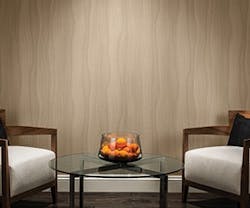If a wallcovering is made of recycled content, is it better than another that can be recycled?
Is a rapidly renewable material more important than one that came from locally sourced lumber?
Is end-of-life disposal as significant as the beginning of the lifecycle chain?
And how exactly do LEED points factor into all of this?
Trying to answer these questions will drive you up the wall. But specifying a sustainable, durable, and cost-effective wallcovering will have you well-suited for the future.
Certifications are crucial for assessing different products and their characteristics, but they differ in what they cover. Let this guide help you make a selection.
Comprehensive Programs
Industry groups like the Wallcoverings Associations (WA) are a good source of unbiased information.
“The Wallcoverings Association wants to define what it means to be sustainable. There are a lot of different claims and characteristics. We try to encompass all those,” explains Rick Hickman, president of WA, a trade association that helped develop NSF/ANSI Standard 342 for wallcoverings. “It should be easy to identify a green product, and you should feel confident that certifications come from a balanced approach.”
Standard 342 considers a product’s entire lifespan across six categories and awards Conformant, Silver, Gold, or Platinum status. The ANSI/NSF process gathers input from several perspectives, including designers, environmental groups, and government agencies.
“The standard covers the whole chain from raw material extraction to end-of-life disposal,” explains Hickman. “If you have the best manufacturing process in the world but deliver the products on big trucks that pump carbon into the atmosphere, that’s not a good tradeoff.”
Multi-attribute certifications can help you see the whole picture.
“It provides clarification, while single-attribute labels can cause confusion,” explains Beth Rich, marketing director for manufacturer LSI Wallcovering. “Having a certified product is great, but having a certified process is huge.”
Another comprehensive, lifecycle certification comes from the Cradle to Cradle (C2C) Products Innovation Institute. It incorporates water use and renewable energy into its process, among other criteria.
“C2C provides transparency and validation, but it also gives us a path to improve on,” says Cliff Goldman, president of manufacturer Carnegie Fabrics. “Thirty years ago, our products relied heavily on fossil fuels during manufacturing. Now they are bio-based and come from sugar cane, a renewable plant material.”
Beware of misleading language, Goldman cautions. Products that are “bio-based” and “bio-preferred” are determined by the USDA and must be at least 25% composed of a rapidly renewable source.
“It’s unfortunate that people have to be skeptical, but it’s also practical,” says Goldman. “Look for third-party input.” PageBreak
Single-Attribute Designations
While some certifications look at the big picture, others provide simply a snapshot of sustainability and focus on one element.
Criteria for Wallcovering Performance
A product isn’t truly sustainable if it doesn’t last. Performance ratings for wallcoverings are detailed in a federal specification, and products are categorized as Type I, II, or III, with higher types being strongest. Before specifying a product, make sure to ask the manufacturer how it ranks in the following characteristics:
- Abrasion resistance
- Breaking strength
- Coating adhesion
- Colorfastness
- Scrubbability
- Stain resistance
A full list of criteria can be found in Federal Specification CCC-W-408.
For a quick fix or just to snag a quick LEED point, some of these labels might be right for you.
For example, if you’re considering wallpaper or wood veneers and want to be environmentally friendly, look for products that have earned Forest Stewardship Council (FSC) certification.
Claims of recycled content should be confirmed by third parties such as SCS Global Services. Recyclability can usually be verified by the manufacturers directly because some offer to take back the product at end of life.
If indoor air quality is your primary concern, look for GREENGUARD certification for low VOCs, says Colleen James, director of marketing for KnollTextiles. “Chemical offgassing can be harmful and time-consuming,” she says.
SCS also uses its Indoor Advantage program to ensure wallcoverings, adhesives, and other interior products support clean IAQ.
Although these certifications aren’t as far-reaching as others, they can still help you identify an attractive, affordable, and durable option.
Cost, Aesthetics, and Performance
A product can earn every certification out there, but if it doesn’t last, is it truly sustainable?
“Clients want something that will perform, even before considering the environmental footprint,” explains Goldman. “If something looks lousy in six months, then it really hasn’t done any good.”
There doesn’t have to be a tradeoff between sustainability and durability, Hickman adds.
“The two terms aren’t mutually exclusive,” he says. “It has taken a lot of research and development, but they can exist together.”
Because your selection should last for at least a decade, appearance is almost as important as performance. Many options are fully customizable with unique colors and patterns.
“The sky is the limit,” says Hickman.
Many eco-friendly offerings are also price competitive, but when sustainability first became the buzz, they came at a premium.
“It took some time for the price point to come down, but it’s there now,” Hickman adds. “So who wouldn’t want to be good environmental stewards?”
From cost to corporate responsibility and aesthetics to abrasion resistance, there are many considerations to mull.
“The right selection will find a happy balance,” says Hickman. “But unless you hit most of these categories, it’s not a winning combination.”
Chris Curtland [email protected] is assistant editor of BUILDINGS.
